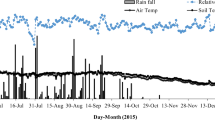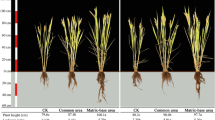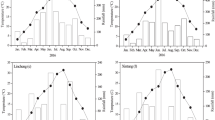Abstract
Nitrogen losses are notoriously high in flooded rice fertilized with urea. An Azolla intercrop can reduce such losses by immobilizing urea-N during periods of potentially high N-loss. The reduction in N loss linked with the absorption and remobilization of urea-N by Azolla, was studied in two greenhouse experiments conducted in Goettingen (Germany). Grain yield and N recovery were positively influenced by Azolla more than doubling grain yield and N uptake as compared to the split application of 300 mg N pot−1 alone (Exp. 1). In the second experiment, the yield increase was 78.3% with single applications of 97.5 and 68.4% after a split-application of a total of 195 mg N pot−1. In both years the effect of urea and Azolla combined exceeded that of the sum of the factors alone, a clear positive synergistic effect on yield and N uptake by rice. Azolla effectively competed with the young rice plants for applied urea, capturing nearly twice the urea-N than the rice plants up to tillering in experiment 1. In the second experiment, 64.6 mg N of the 97.5 mg applied early in the season was immobilized by Azolla within 2 weeks. This represented 63.1% of the total N accumulated in the Azolla. The fraction of Azolla-N derived from urea sank to 36.4 mg within 4 weeks and only 27.2 mg at maximum tillering as a result of Azolla senescence and N-release. Of this 64.6 mg urea N immobilized 28.7% is eventually taken up by the standing rice plant, representing 43.1% of the remineralized, urea-derived Azolla N. Following the second urea application, only 17.9 mg N were immobilized in the Azolla biomass during the 2 weeks, of which 6.9 mg pot−1 were still retained in the Azolla at maturity. At this stage, rice is the more effective competitor for applied N. As much as 42.1% of this immobilized N finds its way into the rice by maturity. Thus, Azolla contributed to the conservation of N in the system, particularly of the urea applied early in the season. Loss of N from the system amounted to no more than 15%. Although the early-applied N directly recovered by the rice plant was low (20%), 2/3 of the N captured by Azolla following this first urea application was released to the system by the time of rice harvest, over 40% of which was available to the rice plant. Azolla thus appears to act as a slow release fertilizer.
Similar content being viewed by others
References
Blaise D and Prasad R 1995 Effect of blending urea with pyrite or coating urea with polymer on ammonia volatilization from surface applied prilled urea. Biol. Fertil. Soils 20, 83–85.
Bremner J M 1995 Recent research on problems in the use of urea as a nitrogen fertilizer. Fertil. Res. 42, 321–329.
Broadbent F E and Tusneem M E 1971 Loss of nitrogen from some flooded soils in tracer experiments. Soil Sci. Soc. Am Proc. 35, 922–926.
Byrnes B H and Freney J R 1995 Recent developments on the use of urease inhibitors in the tropics. Fertil. Res. 42, 251–259.
Christianson C B, Carmona G, Klein M O and Howard R G 1995 Impact on ammonia volatilization losses of mixing KCl of high pH with urea. Fert. Res. 40, 89–92.
De Datta S K 1987 Advances in soil fertility research and nitrogen fertilizer management for lowland rice. In Efficiency of Nitrogen Fertilizers for rice. Freney J R, Wetselaar R, Trevitt A C F and Simpson J R (eds) pp 27–41. IRRI, Los Banos, Phillipines.
De Datta S K, Fillery I R P and Craswell E T 1983 Results from recent studies on nitrogen fertilizer efficiency in wetland rice. Outlook Agric. 12, 125–134.
De Macale M A R and Vlek P L G 2002 The role of Azolla cover in improving the nitrogen use efficiency of lowland rice. In Second Int. Conf. on Sust. Agric. for Food, Energy and Industry (Li Dajeu, ed). Inst. of Botany, CAS, Beijing. Vol. II, 921–930.
Dobermann A, Dawe D, Roetter R P and Cassman K G 2000 Reversal of rice yield decline in a long-term continuous cropping experiment. Agron. J. 92, 633–643.
Engelstad O P, Getsinger J P and Stangel P J 1972 Tailoring of fertilizers for rice. Bull. Y-52, Nat. Fertilizer Development Center, Tennesse Valley Authority, Muscle Shoals, Alabama 35660, USA.
Fillery I R P and Vlek P L G 1986 Reappraisal of significance of ammonia volatilization as an N loss mechanism in flooded rice fields. Fertil. Res. 9, 78–98.
Freney J R, Keerthisinghe D G, Phongpan S, Chaiwanakupt P and Harrington K J 1995 Effect of urease, nitrification and algal inhibitors on ammonia loss and grain yield of flooded rice in Thailand. Fertil. Res. 40, 225–233.
Kikuchi M, Watanabe I and Haws L D 1984 Economic evaluation of Azolla use in rice production. In Organic Matter and Rice. IRRI (1984) Los Banos, Philippines.
Kröck T, Alkämper J and Watanabe I 1988 Effect of an Azolla cover on the conditions in floodwater. J. Agron. Crop Sci. 161, 185–189.
Kumarasinghe K S and Eskew D L 1995 Azolla as a Nitrogen Fertilizer in sustainable rice production. In Nuclear Methods in Soil–Plant Aspects of Sustainable Agriculture. Proceedings of an FAO/IAEA Regional Seminar for Asia and Pacific. Colombo, Sri Lanka, 5–9 Avril 1993, 147–154.
Lumpkin T A 1987 Environmental requirements for successful Azolla growth. In Azolla Utilization. IRRI, Los Banos, Philipppines, 89–97.
Mandal B, Vlek P L G and Mandal L N 1999 Beneficial effects of blue–green algae and Azolla, excluding supplying nitrogen, on wetland rice fields: a review. Biol. Fertil. Soils 28, 329–342.
Mikkelsen D S, De Datta S K and Obcemea W N, 1978 Ammonia volatilization losses from flooded rice soils. Soil Sci. Soc. Am. J. 42, 725–730.
Mohanty S K, Singh U, Balasubramanian V and Jha K P 1999: Nitrogen placement technologies for productivity, profitability and environmental quality of rainfed lowland rice system. In Resource Management in Rice Systems: Nutrients. Balasubramanian V, Ladha J K and Denning G L (eds) pp. 57–77. Kluwer Akademic Publisher, Netherlands.
Okoronkwo N, Van Hove C and Eskew D L 1989 Evaluation of nitrogen fixation by different strains of Azolla-Anabaena symbiosis in the presence of a high level of ammonium. Biol. Fertil. Soils 7, 275–278.
Panda M M, Mosier A R, Mohanty S K, Chakravorti S P, Chalam A B and Reddy M D 1995 Nitrogen utilization by lowland rice as affected by fertilization with urea and green manure. Fertil. Res. 40, 215–223.
Peters G A and Mayne B C 1974 The Azolla, Anabaena azollae Relationship II: Localization of nitrogenase activity as assayed by acetylene reduction. Plant Physiol. 53, 820–824.
Sisworo E L, Rasjid H, Sisworo W H, Wemay J and Anto H 1995 Use of 15N to determine the N-Balance of Azolla-N and urea-N applied to wetland rice. Proceedings of an FAO/IAEA Regional Seminar for Asia and Pacific. Colombo, Sri Lanka, 5–9 Avril 1993, 155–162.
Stangel P J and Harris G T 1987 Trends in production, trade and use of fertilizers: A global perspective. In Efficiency of Nitriogen Fertilizer for Rice, 1987. IRRI, Manila, Philippines.
Van Hove C, Diara H F and Godard P 1983 Azolla in West Africa. WARDA Publ., Bouake, Côte d'Ivoire.
Vlek P L G and Byrnes B H 1986 The efficacy and loss of fertilizer N in lowland rice. Fertil. Res. 9, 131–147.
Vlek P L G and Craswell E T 1981 Ammonia volatilization from flooded soils. Fertil. Res. 2, 227–245.
Vlek P L G and Fillery R P 1984 Improving nitrogen efficiency in wetland rice soils. Fert. Society Proc. 230, 32 pp.
Vlek P L G and Stumpe J M 1978 Effects of solution chemistry and environmental conditions on ammonia volatilization losses from aqueous systems. Soil Sci. Soc. Am. J. 42, 416–421.
Vlek P L G, Diakite M Y and Mueller H 1995 The role of Azolla in curbing ammonia volatilization from flooded rice systems. Fertil. Res. 42, 165–174.
Vlek P L G, Stumpe J M and Byrnes B H 1980 Urease activity and inhibition in flooded soil systems. Fertil. Res. 1, 191–202.
Watanabe I and Liu C C 1992 Improving nitrogen-fixing systems and integrating them into sustainable rice farming. Plant Soil 141, 57–67.
Author information
Authors and Affiliations
Corresponding author
Rights and permissions
About this article
Cite this article
Cissé, M., Vlek, P.L.G. Conservation of urea-N by immobilization-remobilization in a rice-Azolla intercrop. Plant and Soil 250, 95–104 (2003). https://doi.org/10.1023/A:1022878306316
Issue Date:
DOI: https://doi.org/10.1023/A:1022878306316




